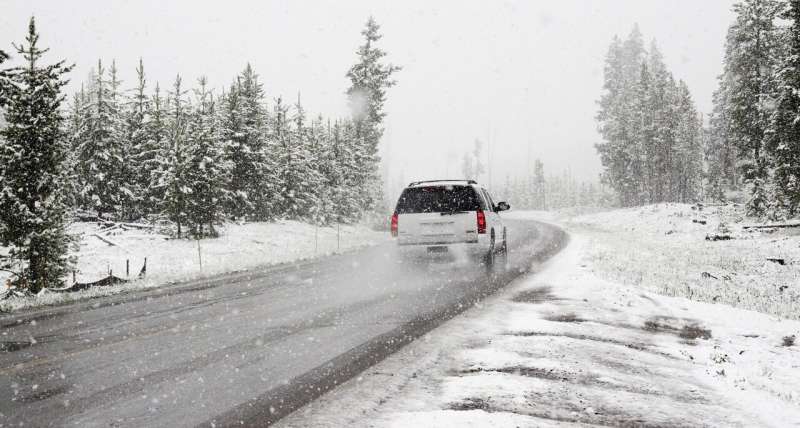Maryland transportation crews using less salt, more brine on icy roads to protect waterways

With the approaching snowstorm predicted to dust the Baltimore area and blanket the Eastern Shore while creating dangerous conditions into Saturday morning, state highway crews and local transportation departments spent Friday preparing the roads.
Crews treating state highways and county roads were expected to scatter less rock salt and spray more brine solution to melt ice on roads before and during the weekend snowfall, a measure aimed at reducing the amount of sodium chloride that runs off highways and contaminates soil and groundwater.
"Our federal and state commitments to clean water ensure that we track different sources of pollution and types of pollution, and increasingly the evidence is clear that road salt and other de-icing chemicals can threaten the quality of our streams, rivers and lakes, and drinking water supplies above-ground and underground," said Ben Grumbles, the Maryland secretary of the environment.
The Maryland Department of the Environment has been working with the State Highway Administration to find alternative methods to clear roads for winter travel that are not as reliant on rock salt. The highway administration said in a statement the agency has cut its overall salt usage in half over a five-year period.
The agency, part of the Maryland Department of Transportation, has used brine in addition to rock salt for more than 10 years, said Sherry Christian, a highway administration spokeswoman.
As extreme weather events become more common, transportation crews are pivoting to less harmful ways to pretreat roadways, such as using brine, a liquid solution with a lower salt concentration—about 22% salt and 78% water. Crews spray brine before a storm to prevent snow and ice from sticking to the road.
Without the pretreatment, the highway administration said it would have to use significantly more rock salt to melt ice from road surfaces after a snowstorm. If a snowstorm starts as rain, however, the department does not apply the pretreatment because it will wash away, Christian said.
The environment department has been working with state and local agencies for several years to apply alternative strategies for applying salt to roads, Grumbles said. The Federal Highway Administration recommends transportation crews use 300 to 500 pounds of rock salt per lane mile during winter events, according to the SHA. Eight years ago, the department was averaging 1,000 pounds of salt per lane mile to melt snow and ice.
The highway administration is now applying half that rate this winter, around 500 pounds of salt per lane mile, a change it considers to be its most dramatic way of reducing salt use, Christian said.
Snowplows also are becoming more efficient at clearing wider areas to prevent the need to repeatedly salt throughout a storm, officials said. The state transportation department has two new "tow plows" that attach to the back of snow plows and clear additional travel lanes by swinging side to side like a broom while dispensing salt. The tow plows are steerable and don't require fuel. They're estimated to cost $86,000 each and are used on I-70 in Howard County and I-68 in Garrett County.
When rock salt is used it's now sprayed with brine right before it's scattered so it's "pre-wet" and sticks to the road rather than bounce off the pavement and possibly ricochet into soil or local waterways. Rocks are sprayed at the spinner in the rear of a dump truck and become a consistency that resembles oatmeal.
Even a relatively low amount of salt can degrade waterways and kill freshwater fish, Grumbles said.
"If it's a trout stream, trout are not meant to live in saltwater. It's altering the chemistry of the waterbody," Grumbles said. "Sometimes slight alterations have significant and fatal impacts."
Toxins like road salts also can destroy soil structure and vegetation, eroding the ground as well as metal, including bridges and snowplows themselves.
Stormwater from melting snow with road salt can seep into groundwater and contaminate private drinking wells, Grumbles added.
Baltimore City and Anne Arundel, Baltimore and Montgomery counties are required by their respective stormwater permits issued by the state environment department to follow State Highway Administration guidance to reduce pollution when treating roads with salt and brine solution, and take steps to improve plow equipment and track the amount of salt used.
State Sen. Cheryl Kagan, a Democrat from Montgomery County, introduced a bill this session that would require commercial property owners and other businesses to be trained and certified in how to apply salt or salt alternatives on roadways, parking lots and sidewalks. Through the "Smart Salt Certification," owners must track their salt usage and submit their records in an annual report to the environment department. The bill will be heard Wednesday before the environmental affairs committee.
Individual homeowners are encouraged to reduce the use of salt and chemical de-icers by shoveling walkways and driveways before snow turns into ice. Salt also also be swapped for natural clay cat litter, which absorbs ice, or sand, which adds traction, according to the state highway administration.
"It can improve the quality of their neighborhood to embrace these alternatives, and being aware of the amount of salt you use and there are options and alternatives to help reduce runoff pollution," Grumbles said.
©2022 The Baltimore Sun.
Distributed by Tribune Content Agency, LLC.



















